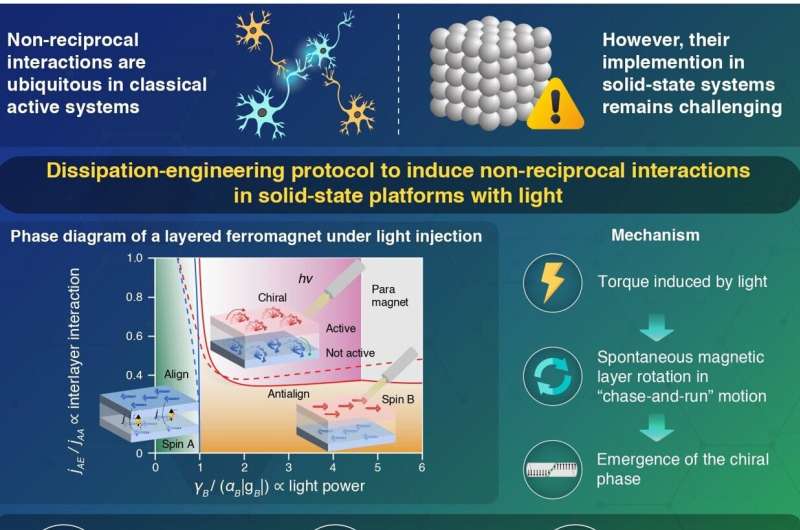Science
Researchers Uncover Light-Induced Magnetism Defying Newton’s Laws

A team of researchers from Japan has achieved a significant breakthrough in materials science by demonstrating how light can induce non-reciprocal interactions in solid-state systems, effectively violating Newton’s third law. This innovative approach, reported by the Institute of Science Tokyo, allows for the creation of persistent rotational dynamics in magnetic materials, introducing a new frontier in the study of non-equilibrium materials.
The findings, published online in the journal Nature Communications on September 18, 2025, reveal that by irradiating a magnetic metal with light at a precisely tuned frequency, researchers can generate a torque that causes two magnetic layers to engage in a continuous “chase-and-run” rotation. The research team, led by Associate Professor Ryo Hanai, collaborated with Associate Professor Daiki Ootsuki from Okayama University and Assistant Professor Rina Tazai from Kyoto University.
In traditional physics, systems in equilibrium obey the principle of action and reaction, as per the free energy minimization principle. However, in non-equilibrium systems—such as biological entities or active matter—non-reciprocal interactions are commonplace. For example, the dynamics between predator and prey or the interactions within the human brain showcase these asymmetrical relationships. The research team aimed to explore whether such non-reciprocal interactions could be effectively implemented in solid-state electronic systems.
“Our study proposes a general way to turn ordinary reciprocal spin interactions into non-reciprocal ones using light,” stated Hanai. The team focused on the well-known Ruderman–Kittel–Kasuya–Yosida (RKKY) interaction in magnetic metals. By selectively activating decay channels for specific spins while leaving others off-resonant, they demonstrated how these interactions can acquire a non-reciprocal character.
Innovative Mechanisms and Applications
The research hinged on a dissipation-engineering scheme that utilized light to selectively activate decay channels within magnetic metals. These materials contain localized spins and conduction electrons, enabling spin-exchange coupling. By manipulating these decay channels, the researchers created an imbalance in energy injection across different spins, leading to the emergence of non-reciprocal magnetic interactions.
Applying this dissipation-engineering approach to a bilayer ferromagnetic system, the team predicted a non-equilibrium phase transition—termed a non-reciprocal phase transition. This phenomenon, previously introduced in the context of active matter, reveals that when exposed to light, one magnetic layer tends to align with the other while simultaneously attempting to anti-align. This interplay results in a spontaneous and continuous rotation of magnetization, leading to a unique “chiral” phase characterized by persistent chase-and-run dynamics.
Importantly, the intensity of light required for inducing these non-reciprocal phase transitions is estimated to be achievable with current experimental capabilities, potentially paving the way for practical applications.
“Our work not only provides a new tool for controlling quantum materials with light but also bridges concepts from active matter and condensed matter physics,” Hanai added. The implications of this research extend to applications in Mott insulating phases of strongly correlated electrons, multi-band superconductivity, and optical phonon-mediated superconductivity.
Future Implications
The potential for this discovery to impact the development of new types of spintronic devices and frequency-tunable oscillators is significant. By harnessing non-reciprocal interactions, the researchers suggest that innovative next-generation technologies may emerge, transforming fields that rely on advanced magnetic materials.
Overall, this study illuminates the applicability of non-reciprocal interactions in solid-state systems, offering a glimpse into the future of materials science and technology. As researchers continue to explore the boundaries of physics, the intersection of light and magnetism may yield results that challenge traditional understanding and inspire new technological advancements.
-

 Health3 months ago
Health3 months agoNeurologist Warns Excessive Use of Supplements Can Harm Brain
-

 Health3 months ago
Health3 months agoFiona Phillips’ Husband Shares Heartfelt Update on Her Alzheimer’s Journey
-

 Science2 months ago
Science2 months agoBrian Cox Addresses Claims of Alien Probe in 3I/ATLAS Discovery
-

 Science2 months ago
Science2 months agoNASA Investigates Unusual Comet 3I/ATLAS; New Findings Emerge
-

 Science1 month ago
Science1 month agoScientists Examine 3I/ATLAS: Alien Artifact or Cosmic Oddity?
-

 Entertainment5 months ago
Entertainment5 months agoKerry Katona Discusses Future Baby Plans and Brian McFadden’s Wedding
-

 Science1 month ago
Science1 month agoNASA Investigates Speedy Object 3I/ATLAS, Sparking Speculation
-

 Entertainment4 months ago
Entertainment4 months agoEmmerdale Faces Tension as Dylan and April’s Lives Hang in the Balance
-

 World3 months ago
World3 months agoCole Palmer’s Cryptic Message to Kobbie Mainoo Following Loan Talks
-

 Science1 month ago
Science1 month agoNASA Scientists Explore Origins of 3I/ATLAS, a Fast-Moving Visitor
-

 Entertainment2 months ago
Entertainment2 months agoLewis Cope Addresses Accusations of Dance Training Advantage
-

 Entertainment3 months ago
Entertainment3 months agoMajor Cast Changes at Coronation Street: Exits and Returns in 2025









